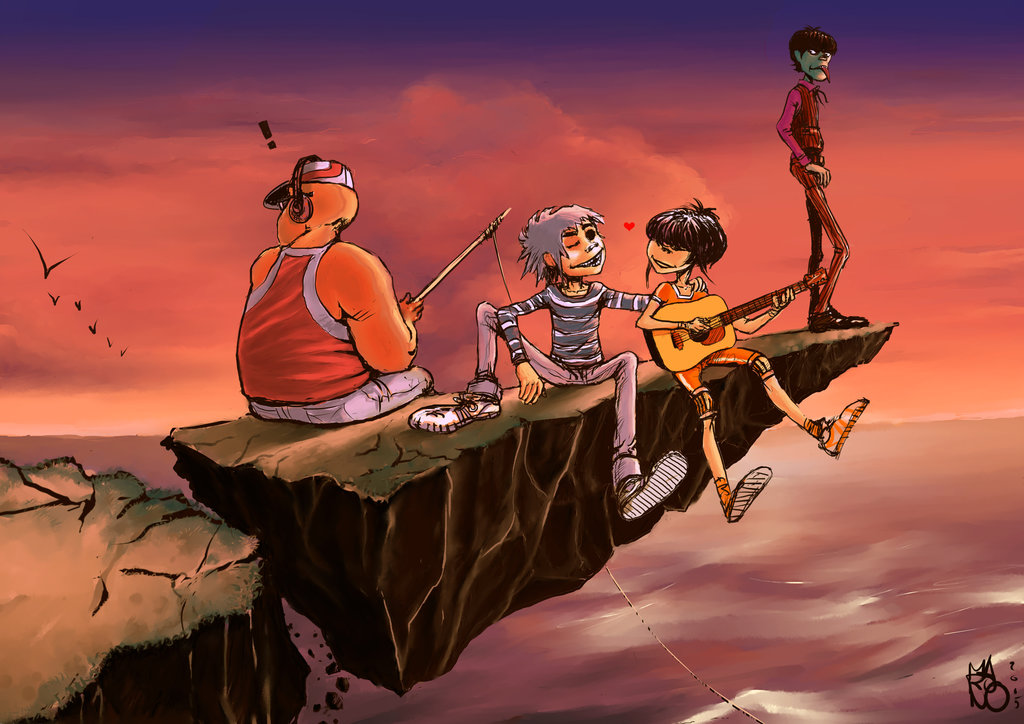With hit songs such as ‘Up on Melancholy Hill‘, ‘‘Feel Good Inc.’, and ‘‘Clint Eastwood’, this British band has topped the charts of the alternative rock scene many times in the last decade. The Gorillaz. Their unique sound and the fact that I like a lot of their songs, is however not the only reason why I decided to blog about this band today. This band is namely one of the biggest (digital and) virtual bands.

Of course the concept of the digital linked to music is not a new concept. Computers have been used for musical production and recordings as early as 1951. In 1957 the first piece of music was created and played on a IBM-704 computer by the MUSIC program. This was invented by Max Mathews (Computer Music Specials 2008). From there, the music producing took off. In 1982 the Commodore 64 was launched, which contained a Sound Interface Device (SID). This SID-chip remains a typical sounds for that era. Think of any typical arcade game and that is exactly the sound that the Commodore 64 is known for. Later, in the 1990s, computers started having audio recording and at the end of the 90s the first plug-in instrument was invented. The analogue, acoustic form of music was entering the digital realm in a fast pace from then. In the 2000s, more modern music processors arrived on the scene. Nowadays, you don’t even need to have the instruments in your studio to emulate the sound of a grand orchestra.
Virtual Bands
In 1998, the year before the first plug-in instrument was invented, Damon Albarn and Jamie Hewlett started the project for the Gorillaz. However early this may be for a virtual band, it is actually not the first virtual band ever. Alvin and the Chipmunks was actually the first in 1958. The virtual aspect was created by Ross Bagdasarian by accelerating his recordings, to create the chipmunk-like sound (Wikipedia). The Gorillaz take a different approach to the concept of the virtual band. The band consists of four virtual members and two non-virtual members. 2-D (lead vocals/keyboard), Murdoc Niccals (bass), Russel Hobbs (percussion) and Noodle (guitar) make up the visual representation of the band (Larson 2012, 1). Music videos are visual representations of their activities made by the co-founder of the band: Jamie Hewlett. Damon Albarn is the founder and manager of the musical component of the band. Throughout the years there have been many people who cooperated with the project, which shows that the number of people who are behind the four-virtual-piece band is almost unlimited.

In the article by Michael Larson there is an interesting analysis concerning the Gorillaz. Since there are visually no limits in what the characters can physically do or experience in the music videos, the artists behind the band can choose to portray their utopian (or dystopian) view of the world. The Gorillaz have continuously throughout their work tried to share ideas about their view of the future.
“The debut album: Gorillaz, without directly invoking much in the way of global issues, stands as a reflection on the mood of life at the end of the modern era.”
Michael Larson 2012, 2
In this fashion the virtual members of the band can highlight the issue of global warming and political controversies, while their human counterparts are not directly seen as the main bearers of the bad news. For example; Plastic Beach, the third studio album by the band, portrays a world withered with plastic and decay.
Thanks to catchy tunes, deep lyrics, and beautiful visuals, the Gorillaz have amassed quite the fan base. The digital way in which the band uses their voice to bring aforementioned problems in the public eye, could perhaps turn into some sort of platform that allows for more open discussions regarding the matter.
References
- Computer Music Specials. October 13, 2008. “A brief history of computer music.” Musicradar. Accessed on September 21, 2018. https://www.musicradar.com/news/tech/a-brief-history-of-computer-music-177299
- Larson, Michael. 2012. “Welcome to the World of the Plastic Beach: Gorillaz and the Future.” TRANS– 14: 1-10. DOI: 10.4000/trans.577.
- Wikipedia. “Virtual Band.” Accessed on September 22, 2018. https://en.wikipedia.org/wiki/Virtual_band



Recent Comments